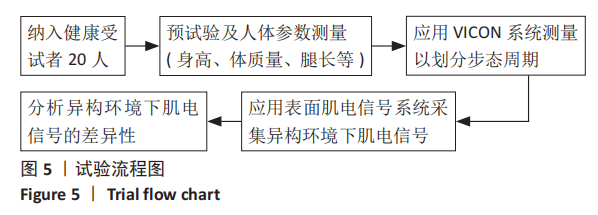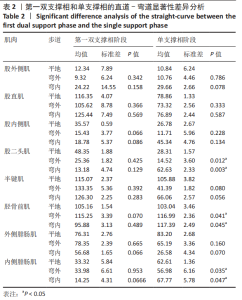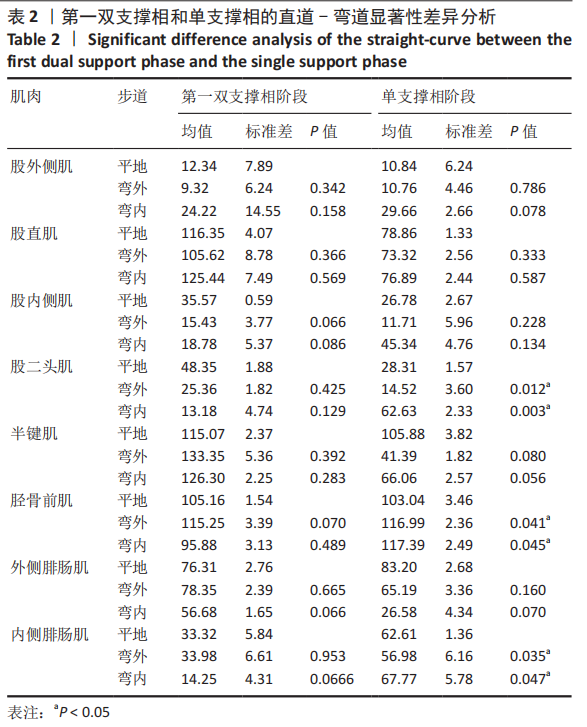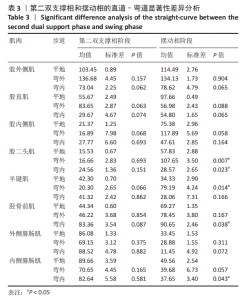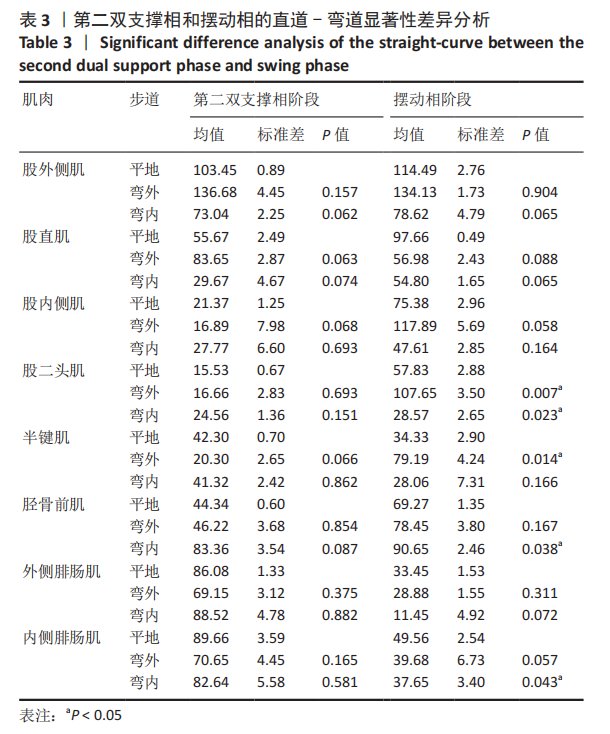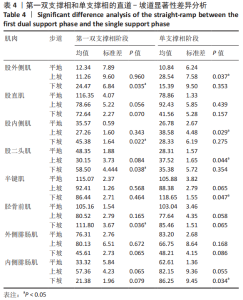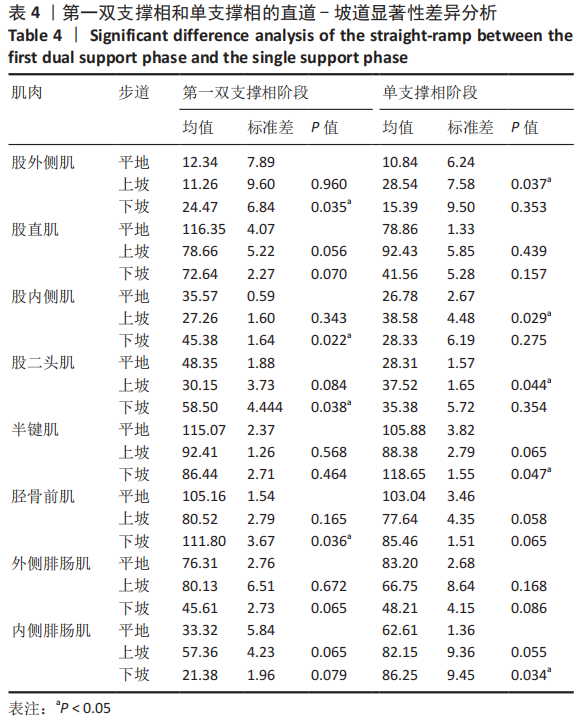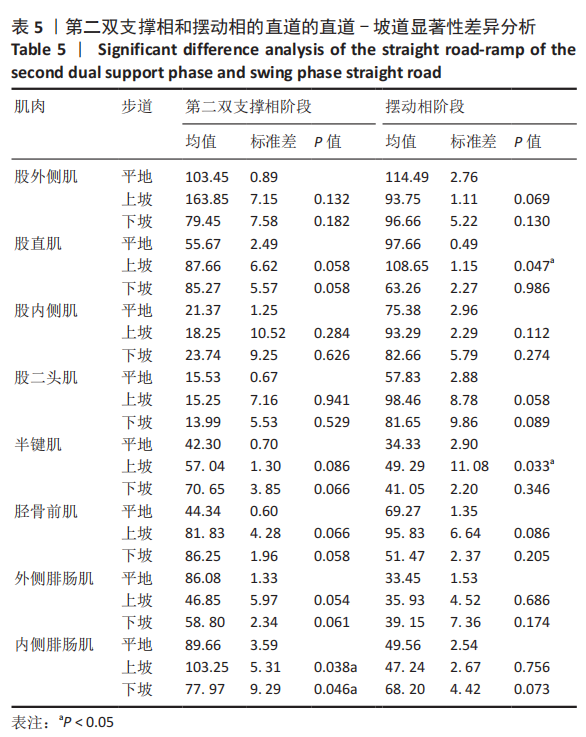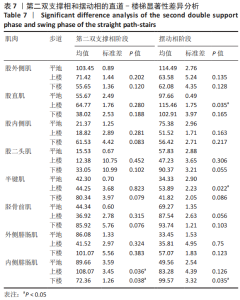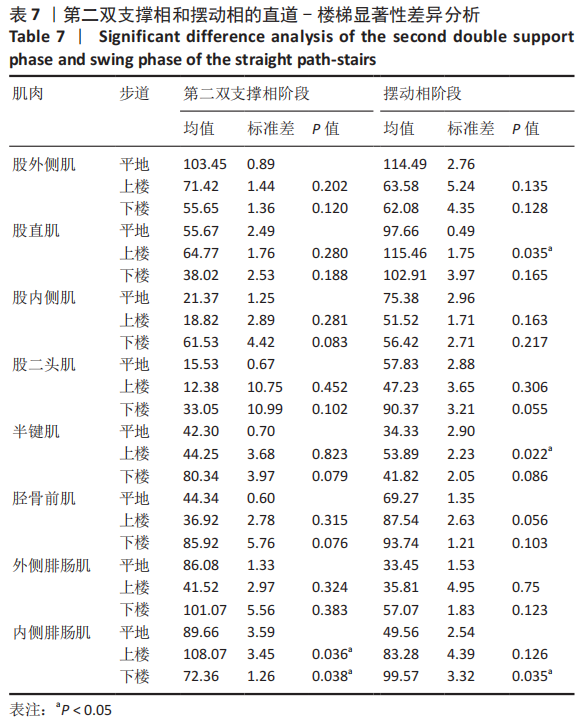Chinese Journal of Tissue Engineering Research ›› 2021, Vol. 25 ›› Issue (36): 5814-5820.doi: 10.12307/2021.348
Previous Articles Next Articles
Surface electromyography characteristics of lower limbs in heterogeneous gait environment
Zhang Peng1, 2, Zhang Junxia1, 2
- 1School of Mechanical Engineering, Tianjin University of Science & Technology, Tianjin 300222, China; 2Tianjin Key Laboratory of Integrated Design and Online Monitoring for Light Industry and Food Engineering Machinery and Equipment, Tianjin University of Science & Technology, Tianjin 300222, China
-
Received:2021-02-27Revised:2021-03-10Accepted:2021-04-23Online:2021-12-28Published:2021-09-17 -
Contact:Zhang Junxia, MD, Professor, School of Mechanical Engineering, Tianjin University of Science & Technology, Tianjin 300222, China; Tianjin Key Laboratory of Integrated Design and Online Monitoring for Light Industry and Food Engineering Machinery and Equipment, Tianjin University of Science & Technology, Tianjin 300222, China -
About author:Zhang Peng, Doctoral candidate, School of Mechanical Engineering, Tianjin University of Science & Technology, Tianjin 300222, China; Tianjin Key Laboratory of Integrated Design and Online Monitoring for Light Industry and Food Engineering Machinery and Equipment, Tianjin University of Science & Technology, Tianjin 300222, China -
Supported by:Tianjin Science and Technology Support Program Funded Project, No. 14ZCZDSY00010 (to ZJX); the Tianjin Postgraduate Research and Innovation Project in 2019, No. 2019YJSB014 (to ZP)
CLC Number:
Cite this article
Zhang Peng, Zhang Junxia. Surface electromyography characteristics of lower limbs in heterogeneous gait environment[J]. Chinese Journal of Tissue Engineering Research, 2021, 25(36): 5814-5820.
share this article
Add to citation manager EndNote|Reference Manager|ProCite|BibTeX|RefWorks

2.3 激活时序分析 通过引入肌肉激活延迟时间来分析下肢肌群的激活时序,受试者在静息状态下,测量10 s sEMG信号,经过数值分析得到10 s内sEMG信号的最大值,设定为激活阈值。截取试验过程中一个步态周期内的sEMG信号,并定位sEMG信号的幅值首次大于激活阈值的时刻点t2,设定肌肉激活延迟时间为: ?t=t2-t1 其中t1为右脚足跟首次触地的时刻点。如果?t的值越大,表示肌肉的激活时序较晚。 经过对各种步道环境下的sEMG信号分析,可以得到各肌肉的激活时序对比,见图6。在平直时,胫骨前肌最先激活,激活时间为80 ms,而股内侧肌和外侧腓肠肌激活的迟滞性较高;在弯外和弯内时,半腱肌的激活都是瞬时性的,胫骨前肌的激活时间较晚;上坡时,各个肌肉的激活时间趋于均匀,平均响应时间为400 ms,而下坡过程中,股直肌和外侧腓肠肌的激活时间明显提前;上楼和下楼运动,肌肉激活时间基本相似,股外侧肌的激活时间是最晚的,股二头肌的激活响应最快。"
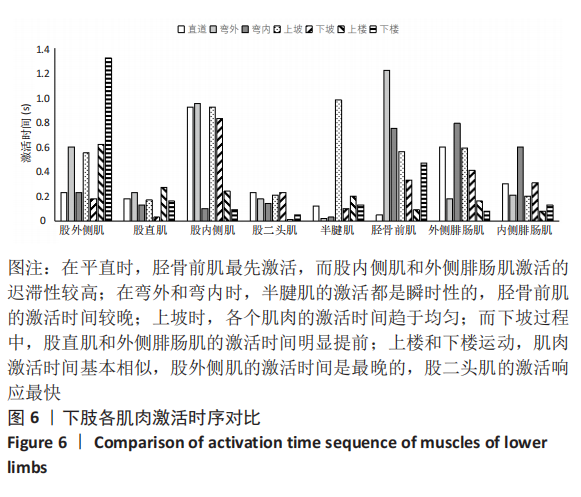
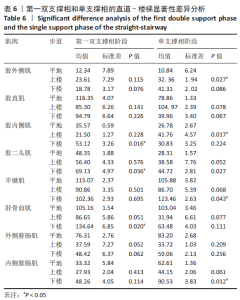
相较于平直,下坡时,在第一双支撑相阶段,股二头肌(P=0.038)、股外侧肌(P=0.035)、股内侧肌(P=0.022)和胫骨前肌(P=0.036)的幅值都显著增大;在单支撑相阶段,半腱肌(P=0.047)和内侧腓肠肌(P=0.034)的幅值显著增大;在第二双支撑相阶段,内侧腓肠肌(P=0.046)显著减小。 2.4.3 直道与楼梯 不同时相下,直道-楼梯显著性差异分析结果见表6,7。与平直相比,上楼过程中,在单支撑相阶段,股外侧肌(P=0.027)和股内侧肌(P=0.017)的幅值显著增大;在第二双支撑相阶段,内侧腓肠肌(P=0.036)的幅值显著增大;在摆动相阶段,股直肌(P=0.035)和半腱肌(P=0.022)的幅值显著增大。"
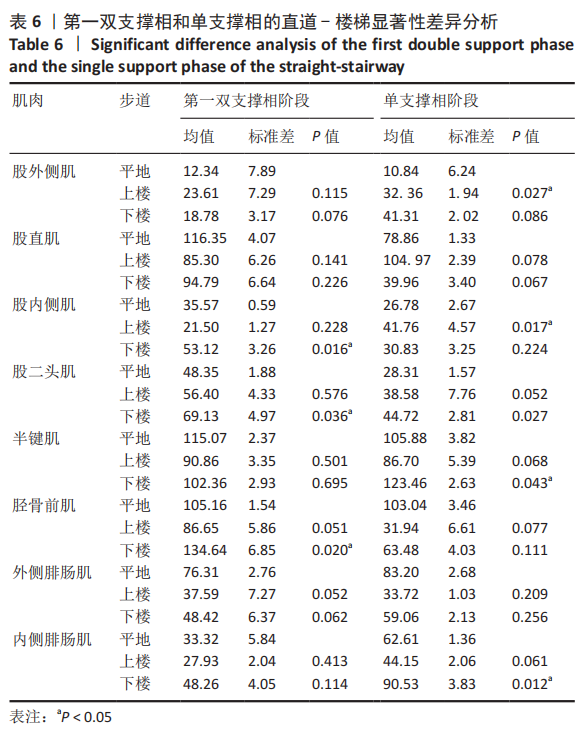
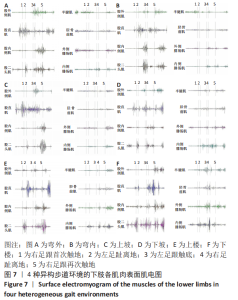
相较于平直,下楼过程中,在第一双支撑相阶段,股二头肌(P=0.036)、股内侧肌(P=0.016)和胫骨前肌(P=0.020)的幅值都显著增大;在单支撑相阶段,半腱肌(P=0.043)和内侧腓肠肌(P=0.012)的幅值显著增大;在第二双支撑相阶段,内侧腓肠肌(P=0.038)的幅值显著减小;在摆动相阶段,内侧腓肠肌(P=0.035)的幅值显著增大。 2.5 四种异构步道环境的下肢各肌肉表面肌电图 以弯外策略进行转弯运动时,各肌肉的表面肌电图见图7A。在单支撑相阶段,相比于直道行走时,支撑腿(右腿)的外旋肌群(股二头肌、内侧腓肠肌)参与运动的能力不明显,激活程度较小。右腿的内旋肌群(胫骨前肌)发生强烈的收缩以保持在转弯过程中身体姿态的相对平衡,因此需要在股直肌、半腱肌、胫骨前肌的位置施加额外的控制助力;在摆动相阶段,摆动腿(右腿)与身体转弯方向是相对的,其运动变化是关节先内旋,然后再外旋改变身体方向。因此,髋关节和膝关节的内旋肌群(股二头肌)和外旋肌群(半腱肌)依次强烈收缩,因此需要在股二头肌、半腱肌和内侧腓肠肌的位置施加额外的控制助力,以保证人体稳定行走。 对于弯内,各肌肉的表面肌电图见图7B。在单支撑相阶段,主要通过转弯腿(右腿)的膝关节外旋肌群(股二头肌)做功完成转弯,需要在股二头肌的位置施加额外的控制助力,同时需要康复机器人在股外侧肌、胫骨前肌位置施加额外的助力协同辅助完成动作;在摆动相阶段,支撑腿(左腿)的外旋肌群(内侧腓肠肌、股二头肌)激活程度较小。而踝关节与路面发生相对运动,为了避免摔倒,踝关节的内旋肌群(胫骨前肌)发生强烈收缩,康复机器人需要在股外侧肌、胫骨前肌的位置施加额外的控制助力。 在上坡时,各肌肉的表面肌电图见图7C。在单支撑相阶段,支撑腿(右腿)位于较高的坡道位置,关节屈曲程度也相对偏大,随着步态时相变换,摆动腿(左腿)开始向更高的坡道位置运动,支撑腿发生伸髋、伸膝运动以提高重心的高度,因此,髋、膝关节的伸展肌群(股二头肌、股外侧肌、股内侧肌)发生强烈收缩,因此康复机器人需要在股二头肌、股外侧肌、股内侧肌和内侧腓肠肌位置施加助力;在第二双支撑相阶段,踝关节的跖屈肌群(内侧腓肠肌)发生强烈收缩以克服重力做功蹬离地面;在摆动相阶段,为了帮助足廓清,摆动腿(右腿)的髋、膝关节的屈曲肌群(股直肌、半腱肌)发生收缩进行屈髋运动和屈膝运动;同时为了保证下肢安全离地,减少跌倒风险,踝关节的背屈肌群(胫骨前肌)也协同强烈收缩,康复机器人需要在股内侧肌、胫骨前肌的位置施加额外的控制助力,以保证人体稳定行走。 在下坡过程中,各肌肉的表面肌电图见图7D。在第一双支撑相阶段,身体有向下运动的惯性,为了保持身体平衡,踝关节的背屈肌群(胫骨前肌)以及髋、膝关节的伸展肌群(股二头肌、股外侧肌、股内侧肌)发生更大的肌肉收缩,康复机器人需要在股二头肌、股内侧肌、外侧腓肠肌的位置施加额外的控制助力;在单支撑相阶段,为了使重心降低,支撑腿(右腿)的膝关节发生屈曲运动,而摆动腿(左腿)为了能到达更低的坡道位置,其屈曲肌群(半腱肌、内侧腓肠肌)会发生强烈收缩,康复机器人需要在半腱肌、胫骨前肌的位置施加额外的控制助力;第二双支撑相阶段,人体只需提供较少的蹬离力量便能够完成步态动作,因此踝关节部位的跖屈肌群(内侧腓肠肌)肌肉收缩程度较小,康复机器人需要在股内侧肌、内侧腓肠肌的位置施加额外的控制助力。 对于上、下楼梯行走过程,各肌肉的表面肌电图见图7E,F。下肢肌群的变化规律与上、下坡基本保持一致,但是楼梯环境需要下肢的运动幅度更大,因此sEMG信号的整体平均幅值变化更大,差异性更明显。相较于坡道行走,较为显著的区别是,在摆动相阶段,为了保持身体姿态平衡,摆动腿(右腿)的踝关节部位跖屈变大,内侧腓肠肌的激活程度更明显,使足尖先着地。"

| [1] 张子华, 庞博, 赵盼超,等.步态测量评价研究进展:步态指数的应用[J].中国康复理论与实践,2020,26(2):210-214. [2] 郭永亮, 卢健军, 冯重睿,等.帕金森病患者慌张步态的三维步态分析[J].中国康复理论与实践,2019,25(7):832-835. [3] 杨智权, 刘爱贤, 聂忆秋.脑梗死患者基于跑台步行的步态分析[J].中国康复理论与实践,2019,25(11):1332-1335. [4] 曾明, 崔尧, 王月丽,等.水中平板步行训练对脑卒中患者步行功能的影响[J].中国康复理论与实践,2019,25(1):76-80. [5] 刘红, 侯美金, 黄武杰,等. 慢性非特异性腰痛三维步态分析的研究现状[J]. 中国康复理论与实践,2019,25(8):882-885. [6] 朱应钊,李嫚.步态识别现状及发展趋势[J].电信科学,2020,36(8): 130-138. [7] KHAN H, NASEER N, YAZIDI A, et al. Analysis of Human Gait Using Hybrid EEG-fNIRS-Based BCI System: A Review. Front Hum Neurosci. 2021;14:613254. [8] FAN H, ZHU H. Motion vector detection based on local autocorrelation coefficient. Cluster Computing. 2017;22(5):11633-11639. [9] 张旻, 陈博, 江澜.两种不同矫形器对早期内侧间室膝关节骨性关节炎步态的影响[J].中国康复医学杂志,2014,29(1):26-30. [10] 李洋, 张峻霞, 王新亭.人下坡行走时对滑移扰动引起的步态失稳的自适应平衡反应[J].高技术通讯,2015,25(12):1053-1061. [11] 李洋, 张峻霞, 苏海龙, 等. 约束复合踝关节运动对人体步态稳定性的影响[J].生物医学工程杂志,2016,33(5):867-872. [12] 苏海龙, 宋黎明, 张峻霞. 意外滑动过程中人体下肢关节与肌群的自主平衡调节作用研究[J].生物医学工程学杂志,2016,33(4):659-665. [13] 李洋, 张峻霞, 司莹. 基于足底压力和步态参数分析的水平行走遇滑失稳的自适应平衡反应研究[J].生物医学工程杂志,2015,32(6): 1217-1222. [14] SUN W, ZHANG XR, ZHANG X, et al. Driving behavior recognition based on orientation and position deviations. International Journal of Sensor Networks. 2019;30(3):161-171. [15] WANG CX, SHAO X, GAO Z, et al. Common network coding condition and traffic matching supported network coding aware routing for wireless multi-hop network. International Journal of Distributed Sensor Networks. 2019;15(6):1-20. [16] XU J, ZHANG YJ, FU KY, et al. SGX-based secure indexing system. IEEE Access. 2019;7:77923-77931. [17] 王新亭, 张峻霞, 徐春,等.基于步态参数的助行器设计方法[J]. 机械设计,2013,30(4):97-100. [18] 吕文, 张锦明, 吕政.表面肌电图在偏瘫患者下肢肌肉动力学分析中的应用[J]. 医学综述,2020,26(24):4883-4886,4891. [19] 苑尧尧, 曹佃国.融合心电与表面肌电特征的下肢康复疲劳估计方法[J].生物医学工程学杂志,2020,37(6):1056-1064. [20] 尹琪敏, 李晓欧.具有表面肌电反馈的功能性阵列电极电刺激系统设计[J].生物医学工程学杂志,2020,37(6):1045-1055. [21] AGGARWAL JK, RYOO MS. Human activity analysis: a review. ACM Comput Surveys (CSUR). 2011;43(3):16. [22] 陆旭婷, 陈响亮. 基于表面肌电探讨模拟现实步态训练对卒中后步行痉挛型老人行走及跌倒恐惧的影响[J].实用老年医学,2020, 34(11):1202-1205. [23] YILMAZ A, JAVED O, SHAH M. Object tracking: A survey. ACM Comput.Surv. 2006;38(4):Article13,45pages. [24] 王慧灵, 冯晓东, 李瑞青.表面肌电图在环咽肌失弛缓患者吞咽障碍评定中的应用[J].中国康复理论与实践,2020,26(11):1275-1279. [25] 王新亭, 伊国富, 张峻霞.基于表面肌电分析老年人负重跨障行走跌倒风险[J].医用生物力学,2020,35(5):615-621. [26] BATZIANOULISA I, EL-KHOURYA S, PIRONDINIB E, et al. EMG-based decoding of grasp gestures in reaching-to-grasping motions. Robotics and Autonomous Systems. 2017;91(5):59-70. [27] KEMPEN JC, DOORENBOSCH CA, KNOL DL, et al. Newly identified gait patterns in patients with multiple sclerosis may be related to push-off quality. Phys Ther. 2016;96(11):1744-1752. [28] VUJAKLIJA I, FARINA D, ASZMANN OC. New developments in prosthetic arm systems. Orthop Res Rev. 2016;8:31-39. [29] 肖农,曾思漾, 陈玉霞, 等. 膝爬运动上肢关节运动轨迹及表面肌电图研究[J]. 中国康复理论与实践,2017,23(5):567-571. [30] 吴琼, 张通, 丛芳,等. 健康成人水中平板步行运动分析[J]. 中国康复理论与实践,2017,23(1):63-67. [31] YOUNG AJ, KUIKEN TA, HARGROVE LJ.Analysis of using EMG and mechanical sensors to enhance intent recognition in powered lower limb prostheses. J Neural Eng. 2014;11(5):056021. [32] 王新亭, 王鸥, 吴永红. 扁平足楼梯行走的下肢表面肌电特性[J]. 中国康复理论与实践,2020,26(8):941-946. [33] BALASUBRAMANIAN V, JAYARAMAN S. Surface EMG based muscle activity analysis for aerobic cyclist. J Bodyw Mov Ther. 2009;13(1):34-42. [34] 黄萍, 齐进, 邓廉夫,等. 正常青年人自然步态下肢肌的表面肌电图分析[J].中国组织工程研究,2012,16(20):3680-3684. [35] 陈泽华, 叶翔凌, 陈伟健,等. 基于足姿指数评分评价旋前足姿对本体感觉和姿势稳定性的影响[J]. 中国组织工程研究,2021,25(9): 1324-1328. [36] 秦现生, 牛军龙, 王战玺等. 人体膝关节运动学和动力学模型研究[J]. 中国医疗器械杂志,2017,41(1):33-37,55. [37] BHASKARAN D, WORTLEY M, CHEN QJ,et al. Effect of a combined inversion and plantarflexion surface on ankle kinematics and EMG activities in landing. J Sport Health Sci. 2015;4(4):377-383. |
| [1] | Yang Fengjiao, Wang Xiangbin, Hou Meijin, Yu Jiao, Li Zhenhui, Fu Shengxing, Lin Ziling, Liu Benke. Comparison of gait characteristics between young and elderly people under dual tasks using three-dimensional gait analysis [J]. Chinese Journal of Tissue Engineering Research, 2021, 25(3): 344-349. |
| [2] | Wang Xin, Luo Wen, Huang Wenze, Xu Yanfei, Ai Yuanliang, Xia Yubo, Zhou Xiaohan, Wang Tao, Guo Ying. Correlation between clinical stage of unilateral knee osteoarthritis and double plantar pressure [J]. Chinese Journal of Tissue Engineering Research, 2021, 25(27): 4312-4317. |
| [3] | Wang Xinting, Xu Dandi, Zhang Junxia, Su Hailong Wang Qi. Stability of load-bearing cross barrier of different arch structures [J]. Chinese Journal of Tissue Engineering Research, 2021, 25(24): 3838-3843. |
| [4] | Jiang Hai, Yu Yu, Liu Zhicheng, Zhang Qiliang. Treatment of plantar fasciitis with extracorporeal shock wave and corticosteroid injection: comparison of plantar pressure and gait [J]. Chinese Journal of Tissue Engineering Research, 2021, 25(21): 3286-3291. |
| [5] | Li Yang, Jiang Shuyun, Li Yiying, Yu Yan, Lu Xiaoying, Wang Danci . Spatiotemporal, kinematic and kinetic characteristics of gait in children with genu valgus [J]. Chinese Journal of Tissue Engineering Research, 2021, 25(15): 2303-2308. |
| [6] | Xu Ping, Liang Leichao, Liang Zhenwen, Cai Ming, Chen Bo, Huang Ping, Zhang Linlin. Surface electromyogram features of the lower limb muscles in cerebral palsy children standing and walking on tiptoes [J]. Chinese Journal of Tissue Engineering Research, 2020, 24(23): 3673-3677. |
| [7] | Chen Haopeng, Xie Hui, Fu Weimin, Wang Benjie, Zhao Dewei. Effect of body mass index on the early-term hip functional recovery after total hip arthroplasty by three-dimensional gait analysis [J]. Chinese Journal of Tissue Engineering Research, 2020, 24(18): 2842-2847. |
| [8] | He Yuanyuan, Ding Chengbiao, Zhang Weiwei, Yan Guang, Sun Mengwen. Plantar pressure changes in older people with sarcopenia [J]. Chinese Journal of Tissue Engineering Research, 2020, 24(14): 2223-2228. |
| [9] | Chen Lingling, Yang Zekun, Sun Jianjun, Zhang Cun. Motion compatibility recognition of walk-aid robot based on multi-scale permutation entropy [J]. Chinese Journal of Tissue Engineering Research, 2019, 23(34): 5473-5478. |
| [10] | Luo Hong1, Liu Fang1, Li Shunhua1, Qiu Bing1, Liu Fuyao1, Zhang Yu2, Ma Limin3. Significance of gait analysis in the diagnosis of anterior cruciate ligament injury [J]. Chinese Journal of Tissue Engineering Research, 2019, 23(31): 4969-4973. |
| [11] | Gao Yaodong, Duan Yuxing, Guo Pengnian. Finite element analysis of three-dimensional entity reconstruction of hip joint based on CT image and hip bearing capacity data [J]. Chinese Journal of Tissue Engineering Research, 2019, 23(28): 4564-4569. |
| [12] | Chen Xuemei1, Wang Congxiao2, Guo Wenling1, Ma Jianlin3, Li Wei2 . Gait characteristics of pregnant women in different pregnancy periods [J]. Chinese Journal of Tissue Engineering Research, 2019, 23(27): 4310-4314. |
| [13] |
Yuan Wangshu, Chen Lixia, Shen Jianxiong, Wang Hai, Yu Keyi, Liu Ying, Zhou Jingya, Lin Youxi.
Correlation of surface electromyogram signals of the apex vertebral paraspinal muscle with Cobb angle and axial trunk rotation angle in adolescent idiopathic scoliosis patients
[J]. Chinese Journal of Tissue Engineering Research, 2019, 23(24): 3824-3828.
|
| [14] | Shen Xuan-lin, Qian Yi-fei, Zhang Jie. Early application of front-ankle-foot orthosis affects the walking ability and speed of the patients with hemiplegia after stroke [J]. Chinese Journal of Tissue Engineering Research, 2013, 17(30): 5551-5556. |
| [15] | Wu Qiang1, Ma Zong-hao2, He Cheng-qi3. Comparison of different orthosis for improving gait in patients with spinal cord injury [J]. Chinese Journal of Tissue Engineering Research, 2013, 17(22): 4152-4160. |
| Viewed | ||||||
|
Full text |
|
|||||
|
Abstract |
|
|||||

